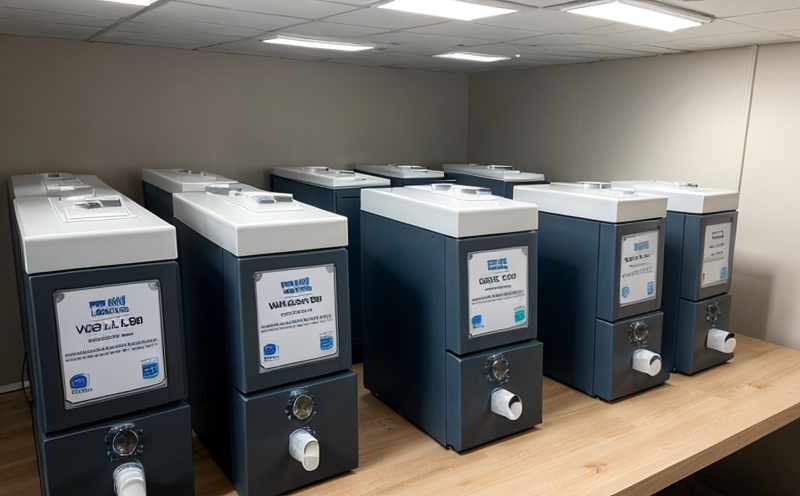Formaldehyde release behaviour of printed fabrics
The formaldehyde release from printed fabrics is a critical parameter in textile testing as it directly impacts both human health and environmental safety. Formaldehyde, a volatile organic compound (VOC), can be released into the air during wear or use of textiles, leading to potential respiratory issues when exposed in concentrations above safe limits.
In the weave sector, printed fabrics are often subjected to various treatments such as printing, dyeing, and finishing processes which may introduce formaldehyde. The release behavior of formaldehyde is evaluated by measuring the amount of free and unbound formaldehyde that escapes from the fabric into its surrounding environment under controlled conditions. This testing ensures that textiles comply with safety regulations and standards.
Testing for formaldehyde release involves exposing a specimen to air, followed by sampling the air at regular intervals or continuously over time. The collected samples are then analyzed using instrumental methods like gas chromatography (GC) or headspace analysis. These techniques provide quantitative data on the concentration of formaldehyde released from the fabric.
Compliance with international standards such as ISO 14929 is essential for manufacturers to ensure their products meet regulatory requirements. This standard specifies procedures for determining the release of volatile organic compounds, including formaldehyde, from printed fabrics under specified conditions. Adherence ensures that the textile meets safety criteria and can be marketed safely without causing harm.
During specimen preparation, it's important to select an appropriate size and shape that represents the fabric as it will be used in its final application. Pre-treatment steps include washing the fabric according to manufacturer guidelines if applicable, drying it thoroughly before testing. This ensures consistent results and minimizes any variability introduced by different manufacturing practices.
The testing procedure typically follows a set protocol outlined in ISO 14929 which details how specimens should be mounted into an apparatus designed for measuring volatile organic compounds. The apparatus simulates real-world conditions where the fabric might interact with air or other materials, allowing accurate measurement of formaldehyde release rates.
Instrumentation used includes gas chromatographs equipped with suitable detectors capable of detecting low levels of formaldehyde in complex matrices like air samples taken from around printed fabrics during testing. These instruments provide precise measurements necessary for meeting stringent regulatory requirements.
The results obtained from these tests are reported quantitatively as parts per million (ppm) or micrograms per cubic meter (µg/m³). Reporting must include information about the specific conditions under which the test was conducted, including temperature, humidity levels, duration of exposure to air, and any pre-treatment steps applied to the specimens.
Understanding formaldehyde release behavior is crucial for quality managers responsible for ensuring product safety; compliance officers tasked with verifying adherence to legal standards; R&D engineers developing new printing techniques or finishes on fabrics; and procurement professionals sourcing raw materials knowing they will contribute towards meeting these important criteria.
Why It Matters
The importance of assessing formaldehyde release behavior cannot be overstated in the context of textile testing. Excessive exposure to low concentrations over prolonged periods can lead to various adverse health effects such as irritation of eyes, skin, nose and throat; headaches; dizziness; nausea; and even more serious conditions like chronic obstructive pulmonary disease (COPD) or asthma.
For manufacturers operating within competitive markets, meeting rigorous formaldehyde limits not only enhances brand reputation but also fosters customer confidence. Consumers increasingly demand safer products that do not pose risks to their health or well-being. By adhering to strict testing protocols and ensuring compliance with relevant regulations, companies can build trust among their target audience.
- Customer Impact: Ensures safe use of textiles reducing health concerns for consumers who may come into contact with them.
- Safety Compliance: Meets national and international standards protecting end-users from harmful exposures.
From a regulatory perspective, compliance helps prevent recalls or legal actions against non-compliant products. It also supports fair competition by leveling the playing field for all participants in the industry who adhere to established guidelines. Additionally, companies that demonstrate commitment to environmental protection may enjoy enhanced public perception and potentially benefit from increased market share.
Customer Impact and Satisfaction
- Safety Compliance: By ensuring formaldehyde levels remain within acceptable limits as per ISO 14929, customers receive products that comply with strict safety regulations protecting their health.
- Health Protection: Reduces risks associated with prolonged exposure to high concentrations of volatile organic compounds like formaldehyde which could otherwise lead to respiratory issues or other serious ailments.
- Environmental Benefits: Encourages responsible sourcing practices that minimize harmful emissions into the atmosphere helping promote cleaner air quality overall.
Customers who purchase textiles from brands committed to rigorous testing and quality assurance can feel assured knowing their products are manufactured responsibly. This commitment translates directly into higher levels of customer satisfaction, which in turn strengthens brand loyalty and enhances long-term relationships between companies and consumers.
Environmental and Sustainability Contributions
Evaluating formaldehyde release behavior contributes significantly to sustainability efforts by promoting responsible manufacturing processes. Reducing emissions of harmful VOCs like formaldehyde helps create a healthier environment for all living organisms, including humans. The use of sustainable practices during the production phase can lead to reduced energy consumption, lower greenhouse gas emissions, and decreased waste generation.
- Reduced Emissions: By minimizing the release of harmful VOCs into the atmosphere, manufacturers play a vital role in improving air quality which benefits both urban and rural areas alike.
- Sustainable Materials: Encourages the development and utilization of eco-friendly materials that have minimal impact on natural resources during processing.
The integration of such practices into everyday operations demonstrates a company's dedication to corporate social responsibility (CSR). It highlights their commitment to creating value not only for shareholders but also for society at large. Such initiatives resonate well with environmentally conscious consumers who prioritize ethical business conduct when making purchasing decisions.





